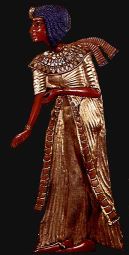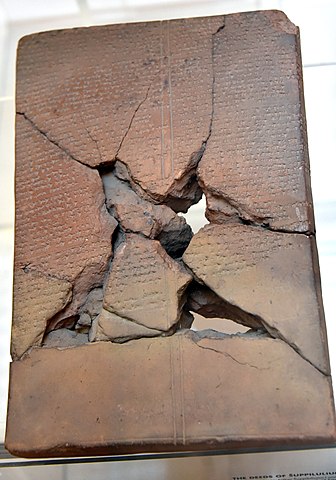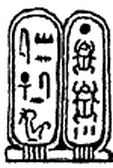

Ever since his tomb was found, Tutankhamun has garnered massive attention and even 100 years after the discovery of his tomb interest in the "boy king" has remained strong. This shrine is not dedicated to him, however, but to his wife, Ankhesenamun, and her plight after his death. These people lived so long ago and a lot of what we know about the history surrounding them and their culture we can only piece together from what they've left behind or what contemporary cultures have written about them. There is so much that is still a mystery to us! But what we do know is that after Tutankhamun died, Ankhesenamun was left alone, the last direct descendent of the 18th dynasty. As the wife of the Pharoah, she had political value. Whoever married her would have the throne of Egypt and become the new Pharoah. Her story has left an impression on me - she was fairly young when Tutankhamun died, she had already lost 2 children and now her husband. This was a very chaotic time in Egypt's history and she was in essence now all alone - a political pawn to be used by whoever could get to her. I feel sorry for this young woman from so long ago. What I find so intriguing about her story is her plea to the Hittite king for help, a request which led to the Zannanza Affair.

We learned of this event not from Egyptian sources but from Hittite ones. Deeds of Šuppiluliuma I and The Plague Prayers of Muršilis relate details of a letter sent to the Hittite king, Šuppiluliuma, by a widowed Egyptian queen asking the king to send her one of his sons. To understand how extraordinary this request was you have to understand the relationship between Egypt and the Hittite Empire. Even though the empires had signed treaties, there were constant proxy wars in their territories. Territories changed hands because local rulers decided to defect to the other side. As an example, the rulers of Kadesh defected to the Hittites. During Tutankhamun's reign, the Egyptians attacked the city while Šuppiluliuma was out of the area. In retaliation, he sent troops to an Egyptian vassal state. And it was during this time that Ankhesenamun's letter found Šuppiluliuma (Witham 2020).

Ankhesenamun is never directly named in these letters. They are said to have come from the "dakhamunzu" which was a Hittite rendering of the Egyptian term for "king's wife." It's not known for certain but many archaeologists believe this was sent by Ankhesenamun as the details and timing seem to fit. This was a widowed queen with no children who was looking for a strong power to keep her from being married off unwillingly and to assume the throne of Egypt (Powell 2022).

Šuppiluliuma received this letter:
For in the meantime, their Lord Nibhururiya* had died, the queen of Egypt - who was Dahamunzu – sent an envoy to my father, saying: “My husband has died, but a son I do not have. But you, they say, have many sons. If you give me one of your sons, he will become my husband, I will never take a servant of mine and make him my husband“ (Güterbock 1956:94, fragment. 28 A iii 11-15).
*Nibhururiya was the Hittite rendering of Tutankhamun's throne name, Nebkheperure.
This was not only surprising because of the context of the times - see above regarding tit-for-tat regional takeovers. Egyptian pharaohs frequently took foreign wives but Egyptian royal women were never married outside of the state. Amenhotep III stated, "From time immemorial no daughter of the king of Egypt is given to anyone." And here we have a widowed queen of Egypt offering herself to a not-entirely-friendly nation. I think even through the ages the disbelief Šuppiluliuma felt at this request can be sensed as, at a gathering of his advisers, he said:
“Nothing like this has ever happened to me in my whole life.”

This offer was so unreal and out of the blue. He thought he was being deceived! He sent his chamberlain to Egypt to get the true story. After many months, the chamberlain returned with an Egyptian diplomat, Hani, and an angry letter from the queen:
Why did you say, “They deceive me,” in that way? If I had a son, would I have written about my own and my country’s shame to another country? Never would I take a servant of mine and make him my husband. I have written to no other country, only to you. They say that you have many sons, so give me one of yours. He will be my husband. In Egypt, he will be king! (Fragment. 28 A iii 50-A iv 12, Güterbock 1956: 96,97)(Witham 2020).
So, she has reiterated that this is a serious request and she has every intention of seeing her new Hittite husband on the throne of Egypt. Šuppiluliuma is still suspicious and told Hani he thought his son would become a hostage instead of a king. He was finally convinced after discussions with Hani and after rereading the ancient treaty between the two empires.

All of this information is from cuneiform texts, written at least a generation after the actual proceedings. We only have a partial history, though. The cuneiform tablets are incomplete and the next thing we find out is that Šuppiluliuma's son Zannanza was sent to Egypt but he was killed. Šuppiluliuma was furious and went on a rampage, attacking Egyptian targets (Podany 2010).

What happened in between the queen's last letter and Zannanza making his way to Egypt? And who killed him? No one really knows. In another set of cuneiform tablets, The Second Plague Prayer of Mursilis II, it is said he was killed by "hostile Egyptians." (Powell 2022) The messenger who brought the news to the king said that the perpetrators escaped so it's possible the Hittites knew who did it but since the tablet is damaged this is not information that we have (Witham, 2020).


After Tutankhamun's death there were two contenders to fill in the power vacuum caused by his untimely death: Horemheb, a commoner who was commander in chief of the Pharoah's armies and Ay, who had served 2 or 3 pharaohs in both priestly roles and as an army commander (van Dijk 1996). They were probably the commoners Ankhesenamun was against marrying. We don't know why Ankhesenamun sent out her plea for a son of the Hittite kingdom. Was it because the contenders for the throne were beneath her in status and she couldn't see herself marrying down? Because she sensed she was an end to a means and might be done away with once the throne was occupied? Was she hungry for power for herself? Or did she sense that uniting the Egyptian and Hittite empires would be the best political move? We can only guess. The last piece of Ankhesenamun's history that we have is from a blue glass finger ring which came to light in the early 20th century. It contains both Ay and Ankhesenamun's names in cartouches (Newberry 1932) so it is apparent that at some point she ended up marrying him. However this must have not been a very long marriage because even though Ay only ruled for a short time, there is no mention in his tomb at all of Ankhesehamun, only of his own wife who he was married to for quite some time.


Works Cited
Osama Shukir Muhammed Amin FRCP(Glasg) - Own work, CC BY-SA 4.0, https://commons.wikimedia.org/w/index.php?curid=72186375
Freewalt, Jason. Ay and the Dahamunzu Affair, American Military University, Academia.edu, 2017, https://www.academia.edu/34161270/Ay_and_the_Dahamunzu_Affair. Accessed 28 Jan. 2023.
Newberry, Percy E. “King Ay, the Successor of Tut’ankhamūn.” The Journal of Egyptian Archaeology, vol. 18, no. 1/2, 1932, pp. 50–52. JSTOR, https://doi.org/10.2307/3854904. Accessed 29 Jan. 2023.
Podany, Amanda. Brotherhood of Kings. Oxford University Press, 2010. https://www.academia.edu/47882777/Brotherhood_of_Kings?auto=download. PDF download
Powell, Eric A. “A Foreign Affair.” Archaeology Magazine, 2022, https://www.archaeology.org/issues/480-2209/features/10758-new-kingdom-succession-crisis. Accessed 28 Jan. 2023.
van Dijk, J. (1996). "Horemheb and the Struggle for the Throne of Tutankhamun" (PDF). https://www.jacobusvandijk.nl/docs/BACE_7.pdf Bulletin of the Australian Centre for Egyptology: 31–33. Accessed 28 Jan. 2023.
Witham, D 2020, The Battle of Kadesh: Its Causes and Consequences, Master of Arts Thesis, University of South Africa, viewed Jan 28, 2023, https://core.ac.uk/download/pdf/477912926.pdf.